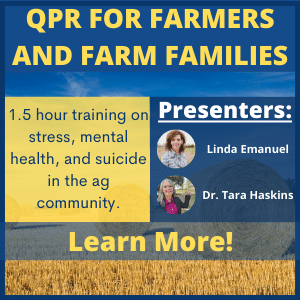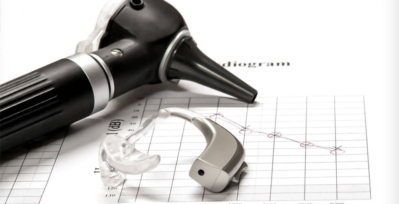Last updated on June 24th, 2024 at 02:28 pm
Hearing Loss Prevention Resources
Noise-induced hearing loss is common in agricultural work. In fact, agriculture is listed in the top 3 occupations that cause hearing loss. Noise-induced hearing loss is permanent and can lead to a diminished quality of life. Studies have shown it can contribute to isolationism and depression. Hearing loss is usually gradual and may go unnoticed for several years, and it does not only effect older adults, but effects all ages, including young adults and teens.
Some key indicators of hearing loss include:
- Frequently asking people to repeat things
- Continually turning up the volume on a television or radio
- Hearing ringing in your ears (known as tinnitus)
- Experiencing difficulty with hearing and understanding conversations in noisy or public areas
- Noticing changes in common noises from your work environment (they sound different, distant, or quieter)
For years, loss of hearing has been accepted as part of the job in ranching and farming. AgriSafe believes that hearing loss is preventable, and there are measures that can reduce your risk of hearing loss.
Hearing Loss Prevention Suggestions:
- Talk to your healthcare provider now about hearing loss, and get a hearing baseline exam.
- Ask your healthcare provider to check for and remove wax buildup in your ears.
- Do not put stuff in your ears (such as q-tips or cotton swabs) – while swabs might pull out some wax, they also push wax and dirt deeper into the ear (if necessary, you can try out drops that help soften and dislodge wax buildup).
- Noise is considered dangerous at 85 decibels and above – if you come into contact with sounds that exceed that noise level, it is recommended that you wear hearing protection (these dangerous sound levels include grain dryers, grinders, saws, lawn mowers, and squealing animals).
- Use a sound level meter to check noise in your work areas.
- Use hearing protection equipment. The three main types include: insertable, formable earplugs; insertable, pre-formed earplugs; and earmuffs. NIOSH-approved protection will have a noise reduction rating (NRR) that serves as a guide for what to purchase. Make sure that your protective equipment fits properly and is comfortable.
The best protection is the one that you will wear!
Hearing Loss Prevention Resources
Resource Library
| ID | Title | Summary | Link |
|---|---|---|---|
| 9377 | Have You Heard? Hearing Loss Caused by Farm Noise is Preventable! | A guide (created by NIOSH) to protecting your hearing on the farm. | |
| 14680 | Hearing Loss | episode of Talking Total Farmer Health | |
| 14650 | Hearing Loss Prevention Training Kit | This kit was developed by the Great Plains Center for Agricultural Health (GPCAH) staff to help farmers decrease their chances of experiencing noise-induced hearing loss and … | |
| 7151 | Hearing Loss Prevention: Adapting the Hearing Conservation Program for Agriculture | Adapting the OSHA Hearing Conservation Program to Agriculture | |
| 8000 | Personal Protective Equipment: OSHA Guidance | This OSHA publication provides a general overview of personal protective equipment requirements and selection. | |
| 9376 | They’re Your Ears: Protect Them | A guide created by NIOSH for protecting your hearing. |
Webinars
| Webinar Title | Summary | Link |
|---|---|---|
| Chainsaw Safety Training | The Chainsaw Safety training program is intended for workers and managers in the agricultural and forestry industries. The major focus of the program is on the identification of and the safe operation of chainsaws. According to the Centers for Disease Control and Prevention (CDC), approximately 36,000 people are injured by chainsaws annually. | |
| Farmer’s Preferences for Hearing Protection Devices: Do Educational Interventions Work? | Although 44% of Midwestern farmers reported noise-induced hearing loss (NIHL) symptoms, less than one third report using hearing protection devices (HPDs) when working around loud noises. Few studies have evaluated which HPD models farmers prefer to wear, and how educational activities may influence this preference. Dr. Gibbs will be discussing current research on farmer’s priorities and preferences for HPD types, as well as the impact of several hearing conservation education activities. | |
| Increasing the Use of Hearing Protection Among Farmers: Best Practices | Nurses in a variety of clinical settings who provide care for farm operators and farm youth are in a unique position to influence the noise mitigation behaviors of this high-risk and underserved group. In this Webinar designed for nurses caring for workers in production agriculture, learners will discuss methods of assessing worker exposure to hazardous noise, and evidence-based nursing approaches to protect workers from the negative effects of noise on hearing and worker well-being. | |
| Invest in Your Health: Say What? Protecting Your Hearing (December 13, 2021) | This Train the Trainer course is designed for teachers, Extension staff, 4H and FFA leaders and others who work with young adults. The young ag producer works in an environment with noise hazards and plays in an environment with noise hazards. Noise-induced hearing loss (NIHL) is common (and preventable) but unfortunately, use of hearing protection among youth is not. |
Websites
- Hearing Disorders and Deafness
- Hearing Loss Among Farmers and Agricultural Workers
- OSHA Youth in Agriculture
Page updated: July 2021




